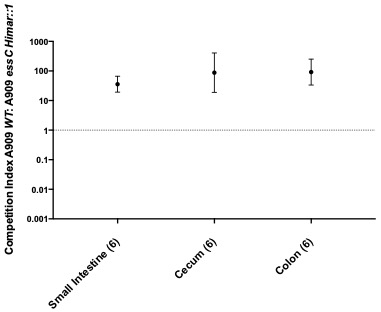Neonatology
Session: Neonatal Infectious Diseases/Immunology 1
588 - Characterizing the role of the Type VII Secretion System in a murine model of Group B Streptococcus intestinal colonization
Friday, May 3, 2024
5:15 PM - 7:15 PM ET
Poster Number: 588
Publication Number: 588.104
Publication Number: 588.104

Cole Turner, DO (he/him/his)
Neonatal-perinatal Medicine Fellow
New York University Grossman School of Medicine
New York, New York, United States
Presenting Author(s)
Background: Late-onset (LO) disease is the most common clinical presentation of Group B Streptococcus (GBS) infection during infancy. Gastrointestinal (GI) colonization with GBS is an important precursor to LO disease. Little is known about the host-microbial-environmental interactions that influence GBS intestinal colonization. The Type VII secretion system (T7SSb) is an important virulence factor in various gram-positive bacteria. A membrane-embedded ATPase, termed EssC, powers substrate secretion across the bacterial membrane and is essential to T7SSb function. T7SSb’s role in GBS pathogenesis has not been well defined. We hypothesize that the T7SS is required for sustained GBS GI colonization.
Objective: To determine the role of GBS T7SSb in a murine model of GI colonization.
Design/Methods: We used 2 bacterial strains: a wild-type (WT) GBS (A909 background - serotype Ia) and a T7SSb mutant GBS strain (essC::Himar1, transposon inserted). Preweaning C57BL/6J mice (12-14 days of life) were orally inoculated with GBS strains in monocolonization and cocolonization experiments. Euthanasia was performed and the GI tract (small intestine, cecum and colon) was harvested at 7-days post infection in all cohorts. We examined the contribution of T7SSb to GI colonization by determining competitive indices during cocolonization experiments. We also assessed bacterial burden and colonization status in monocolonization experiments.
Results: In cocolonization, WT GBS A909 efficiently outcompeted the essC::Himar1 mutant throughout the GI tract at 7 days post infection with a geometric mean competitive index of 35.7, 95% CI [19.2, 66.3] in the small intestine; 87.6, 95% CI [18.9, 407] in the cecum and 91.7, 95% CI [33.3, 252] in the colon at 7 days post colonization (Figure 1). In monocolonization, we noted similar rates of GI tract colonization (p=NS, Fisher’s exact test) (Figure 2A) and no difference in bacterial burden across the GI tract between the 2 groups (p=NS, 2-way ANOVA test) (Figure 2B).
Conclusion(s): T7SSb provides GBS with a competitive advantage in cocolonization experiments over a transposon inserted mutant strain. Monocolonization experiments show similar rates of colonization and bacterial burden by the mutant strain. Our results suggest that T7SSb plays an important role in bacterial competition but is likely not an essential factor for GI colonization. Exploring the role of T7SSb in mediating interbacterial interactions and niche establishment can yield important information regarding GI colonization dynamics.

.png)
